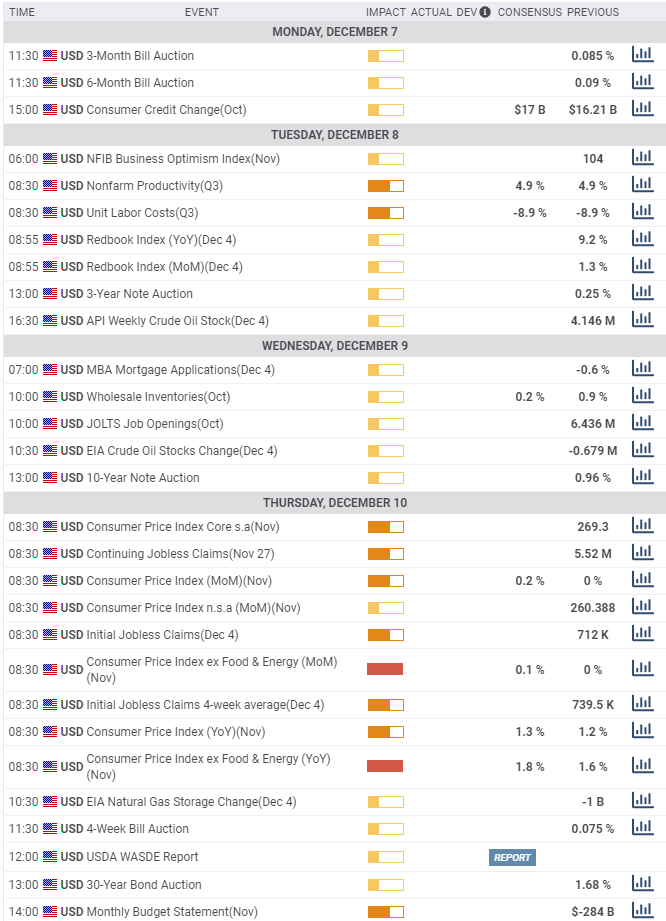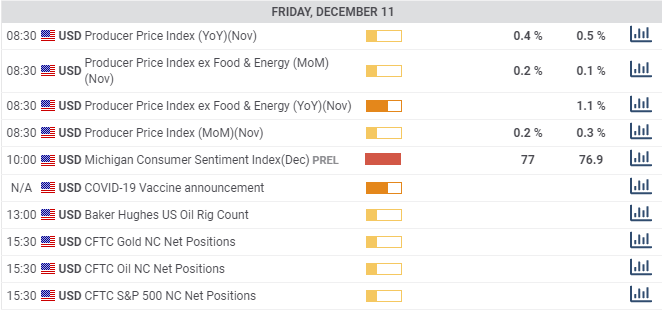- USD/CAD drops to lowest in two-and-a-half years on employment data.
- West Texas Intermediate closes at $46.26, highest since March 4.
- USD/CAD technical support levels now from the first half of 2018.
- US dollar stays out of market favor as COVID-19 spreads.
- FXStreet Forecast Poll preicts a potential reversal.
Unexpectedly strong Canadian employment helped propel the loonie to its best level in more than two years as US job creation fell by more than half in November, pressured by the business closures ordered by several state governments. The USD/CAD closed at 1.2778 on Friday its lowest finish since May 10, 2018.
Statistics Canada's November Employment Change reported 62,100 new workers, more than triple the 20,000 forecast, bringing the total hired to 80.9%, 2.430 million of the 3.004 million layoffs in March and April. In contrast, US Nonfarm Payrolls rose by just 245,000, its lowest addition of the pandemic and less than half the 469,000 projection. Total US re-employment is about 55%.
West Texas Intermediate(WTI) easily stayed above its $43.50 support closing at $46.15 on Friday. The best finish since $46.34 on March 5 gave the resource heavy Canadian economy and its currency a potential boost. Crude prices remained bid even though the oil producers partial cartel, known as OPEC Plus (Organization of Petroleum Exporting countries and Russia), agreed to a modest production increase of 500,000 million barrels a day in January.
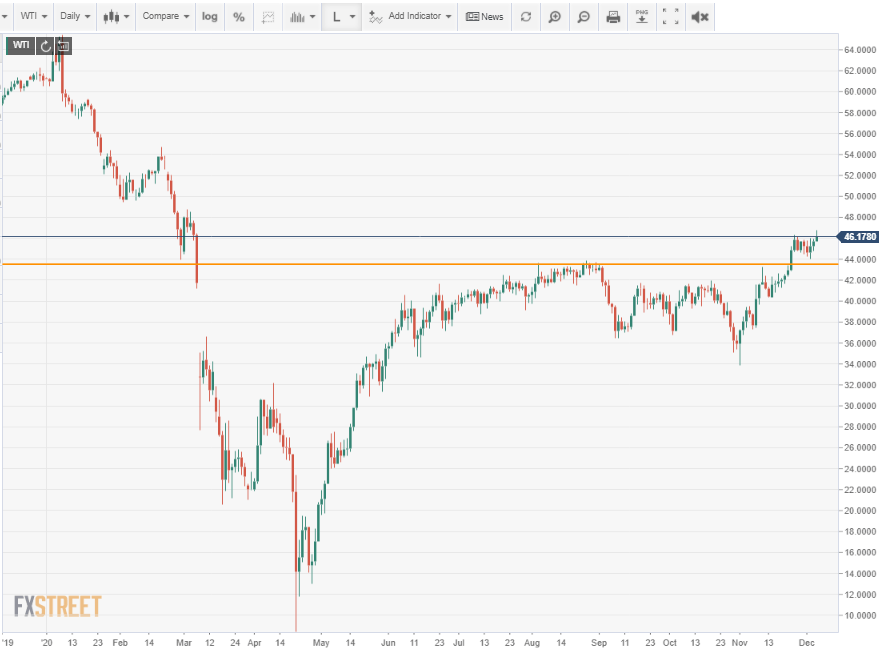
Last Friday's (11/27) USD/CAD close at 1.2990 seemed to promised an imminent test of the 1.3000 and 1.2930 support lines. Monday's attempt to move back above support failed with a close at 1.3000 and Tuesday's trading completed the hypothetical finishing at 1.2924. Wednesday trading repeated the performance, failing to hold above 1.2930, with a high of 1.2958 and a close at 1.2918. It was followed by Thursday's drop to 1.2848 and then the week's largest decline on Friday aided by Canadian employment data.
The steep descent of the USD/CAD since the middle of November has not yet produced any appreciable rebound. The combined Thursday and Friday drop has returned the pair to the ranges of the second quarter of 2018 and earlier. Technical references at that distance are weak and more signposts than records of trading interest.
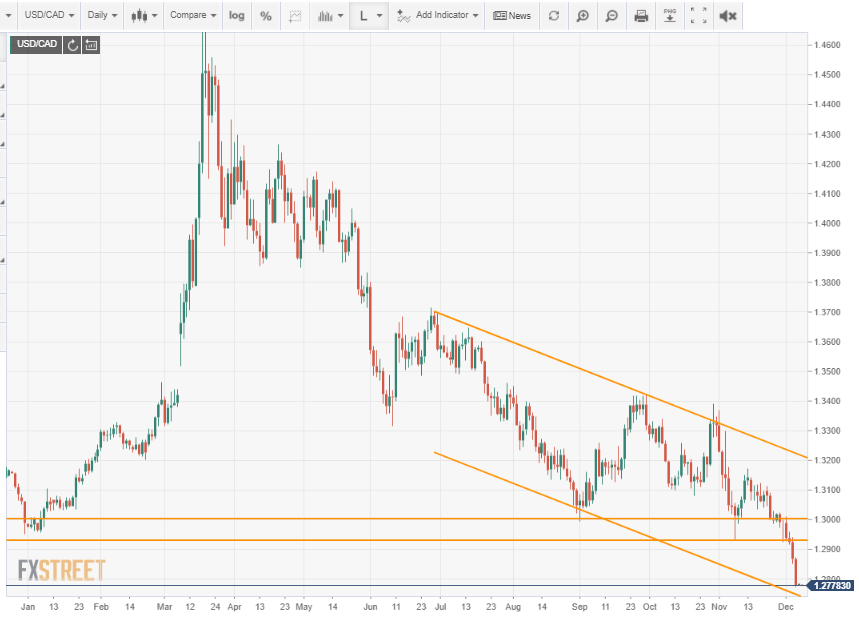 USD/CAD outlook
USD/CAD outlook
Trading in the USD/CAD this week was, as it has been for at least three months, a US dollar story.
Currency markets continue to punish the greenback for the pandemic resurgence in much of the country, though it is largely true that the areas that had the worse infections in the spring, as New York and New Jersey, do not have as numerous an outbreak this time.
The difference between the States, Europe and Canada seems to be a matter of timing, with the later surge in the US dominating headlines. It is the potential for economic damage that is the most relevant. The weakness in US payrolls underlined the negative possibilities even though Initial Jobless Claims reverted to trend at 712,000 in the November 27 week after rising to 778,000 in the previous release.
The November employment data was a clear win for the Canadian dollar but the balance of economic information is much more ambiguous. Canadian third quarter annualized GDP was weaker than expected while manufacturing PMI was on a par with that in the US. The Fed is far more active in restraining US rates, but in reality its intervention is effective against the yield curve in both markets.
The outlook for the USD/CAD is lower. A combination of momentum, weak support from two-year-old levels, and the general negative bias for the US dollar will continue to weigh on the pair. However, the speed of last week's descent and the untraversed ranges leave the USD/CAD open to a profit-taking bounce. A possible catalyst could be a completed stimulus package in the US Congress.
Technically, the USD/CAD is heavy and the descending channel is the main formation. Support lines are weaker and far less important since they date from over two years ago and all of the resistance levels except the first at 1.2800 are of recent vintage.
Canada statistics November 30-December 4
Monday
Raw Material Price Index for Canadian manufacturers rose 0.5% in October after a 2.2% gain in September. The Industrial Prices index fell 0.4% in October, missing its 0.1% forecast and September's -0.1% result.
Tuesday
Third quarter annualized GDP rose 40.5%, less than the 47.6% prediction but ahead of the prior 38.1% decline. On the month in September GDP gained 0.8% following Augusts revised 0.9% increase. Markit's Manufacturing PMI climbed to 55.8 in November from 55.5. It was the highest score since August 2018.
Friday
The Unemployment Rate in November fell to 8.5%, forecast and prior had been 8.9%. The Net Change in Employment added 62,000 jobs, more than three-times the 20,000 projection though less than October's 83,600. Average Hourly Wages rose 4.84% on the year in November down from 5.25% in October. The Participation Rate was 65.1 in November and 65.2 in October. The International Merchandise Trade Balance in October was -C$3.76 billion on a -C$3 billion forecast and September's -C$3.25 billion. Exports rose to C$46.47 billion in October from C$45.54 billion and Imports climbed to C$50.23 billion from C$48.79 billion.
US statistics November 30-December 4
Service and Manufacturing PMIs were largely as expected and though the New Orders Indexes in both sectors were much stronger than forecast they gave the dollar no support. Weak Nonfarm Payrolls and the unemployment rate also did not impact the dollar's decline.
Tuesday
ISM Manufacturing PMI for November came in at 57.5, below the 58 estimate and October's 59.3. The six-month average of 55.8 is the best in two years. Employment dropped below 50 to 48.4, lower than the 51.4 forecast and October's 53.2. New Orders at 65.1 were much stronger than the 53.4 prediction, following October's 17-year high at 67.9. Construction Spending rose 1.3% in October, beating the 0.8% estimate but September was revised sharply lower to -0.5% from 0.3%
Wednesday
The Fed's Beige Book, an anecdotal rendering of the US economy prepared for the December 15-16 FOMC meeting, said the US recovery picked up to a “modest or moderate' pace in the fall but that growth began to slow in November as COVID-19 diagnoses spread in many parts of the country.
Thursday
Services PMI slipped to 55.9 in November from 56.6, just missing the 56 forecast. The New Orders Index dropped to 57.2 from 58.8, but it was far better than the 49.6 forecast. Employment improved unexpectedly to 51.5 from 50.1, besting the 50.9 forecast. Initial Jobless Claims reverted to trend after rising for two weeks, falling to 712,000 in the November 20 week from 787,000. Continuing Claims fell to 5.52 million from 6.089 million. The forecast was 5.915 million. Challenger Job Cuts for November fell to 64.797 million form 80.666 million in October
Friday
Nonfarm Payrolls dropped to 245,000 in November from October's revised 610,000, missing the 469,000 forecast. The unemployment rate (U-3) fell to 6.7% from 6.9%. The underemployment rate (U-6) dropped to 12% from 12.1%. Average Hourly Earnings rose 0.3% on the month and 4.4% on the year. Average Weekly Hours were unchanged at 34.8 and the Labor Force Participation Rate dropped to 61.5% from 61.7%. Factory Orders rose 1% in October on a 0.8% forecast and September was revised to 1.3% from 1.1%.

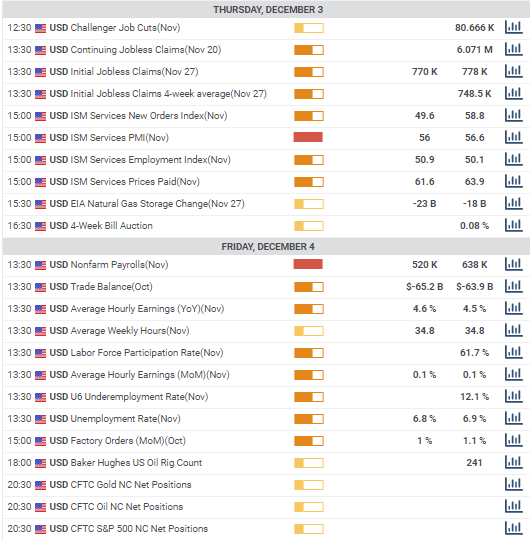 FXStreet
FXStreet
Canada statistics December 7-December 11
The Ivey PMI will have some interest, though not market moving, for its take on November business.
The Bank of Canada rate decision is a foregone conclusion but Governor Tiff Macklem's remarks on the Canadian recovery will warrant attention. The more optimistic he is the better for the Canadian dollar.
Monday
Ivey Purchasing Managers' Index for November is expected to fall to 51.5 from 54.5.
Tuesday
The Bank of Canada will issue its rate decision, no change from the current 0.25% is expected.
Friday
Capacity Utilization for the third quarter is expected to drop to 70.2% from 70.3%.
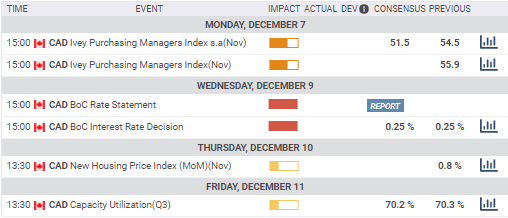 FXStreet
FXStreet
US statistics December 7-December 11
Initial Jobless Claims we be the focus after the poor November NFP, higher results will weaken the dollar. Michigan Consumer Sentiment for December will be eyed for indications on holiday shopping and fourth quarter growth.
Tuesday
National Federation of Independent Business Small Business Optimism Survey for December is issued, November was 104.
Wednesday
The Job Openings and Labor Turnover Survey (JOLTS) for November is out, October was 6.436 million.
Thursday
The Consumer Price Index (CPI) for November is forecast to rise 0.2% on the month from flat and 1.3% from 1.2% on the year. The core index will rise 0.1.% from flat and 1.8% from 1.6% for the year.
Initial Jobless Claims will drop to 700,000 in the December 4 week and Continuing Claims will fall to 4.98 million in the November 27 week.
Friday
The Producer Price Index for November is forecast to add 0.2% monthly and 0.4% annually. The core index is expected to rise 0.4% on the month and 1.1% on the year.
The Michigan Consumer Sentiment Index is predicted to edge up to 77 in December from 76.9 in November.
USD/CAD technical outlook
The predominant technical factor is the weak support with no relevant lines of more recent origin than May 2018. Given the overwhelmingly negative sentiment on the US dollar momentum should continue to test lower. But the rapidity of the recent decline makes it vulnerable to a profit-talking bounce. The fundamental picture is not truly biased against against the US currency, but without a catalyst to change sentiment a purely technical reversal of fortune is unlikely.
 The Relative Strength Index is oversold at 23.15 but that will not be sufficient to generate a reversal. The closest moving average is the 21-day at 1.2997 which will reinforce the already strong resistance at 1.3000. The 100-day average at 1.3181 and 200-day at 1.3511 are, for the moment, irrelevant.
The Relative Strength Index is oversold at 23.15 but that will not be sufficient to generate a reversal. The closest moving average is the 21-day at 1.2997 which will reinforce the already strong resistance at 1.3000. The 100-day average at 1.3181 and 200-day at 1.3511 are, for the moment, irrelevant.
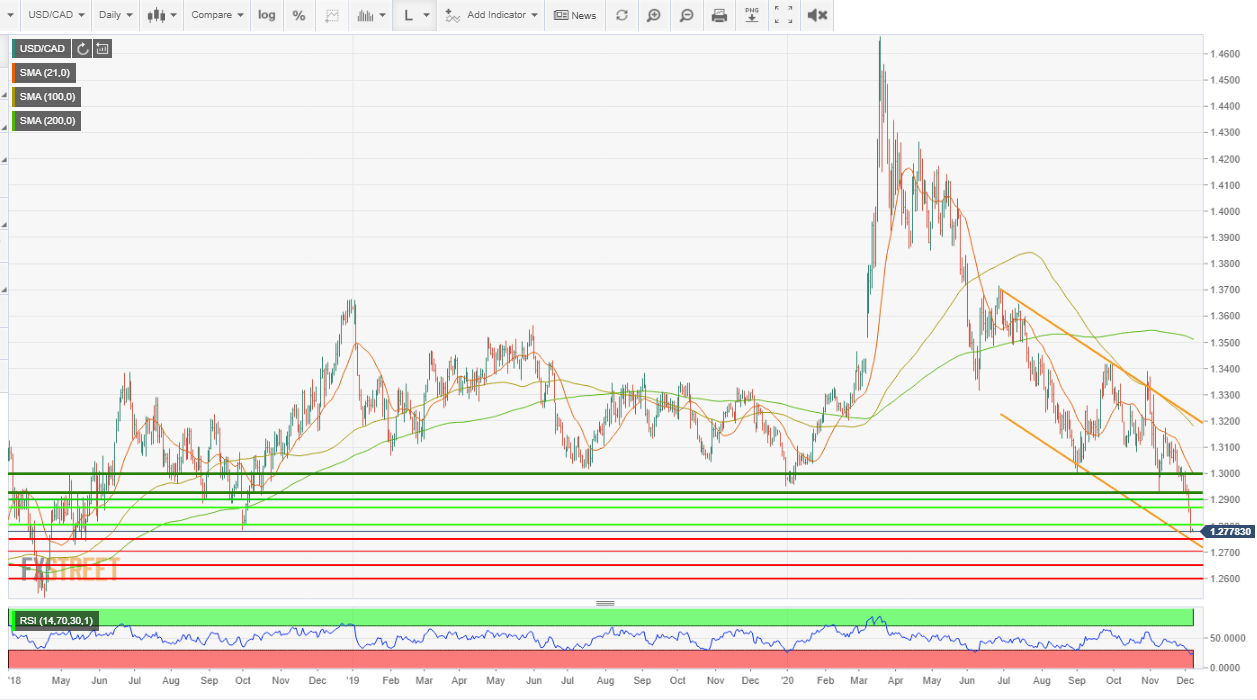 Resistance: 1.2800, 1.2870; 1.2900; 12930; 13000
Resistance: 1.2800, 1.2870; 1.2900; 12930; 13000
Support: 1.2750; 1.2705; 1.2650; 1.2600
USD/CAD Forecast Poll
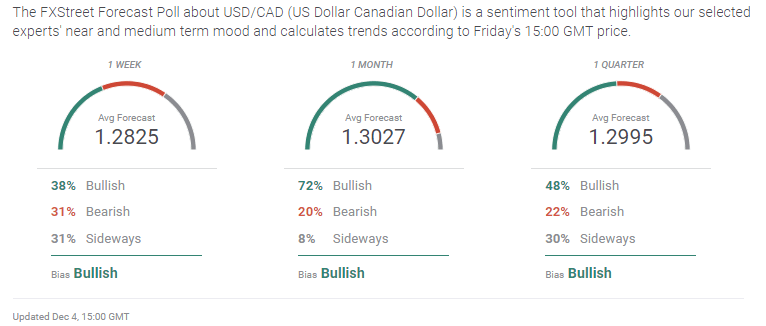 The uniformly bullish FXStreet Forecast Poll underlines the potential for a profitable bounce. Momentum has carried the USD/CAD beyond fundamental economic comparisons, trading logic could well supply the counterweight.
The uniformly bullish FXStreet Forecast Poll underlines the potential for a profitable bounce. Momentum has carried the USD/CAD beyond fundamental economic comparisons, trading logic could well supply the counterweight.
Information on these pages contains forward-looking statements that involve risks and uncertainties. Markets and instruments profiled on this page are for informational purposes only and should not in any way come across as a recommendation to buy or sell in these assets. You should do your own thorough research before making any investment decisions. FXStreet does not in any way guarantee that this information is free from mistakes, errors, or material misstatements. It also does not guarantee that this information is of a timely nature. Investing in Open Markets involves a great deal of risk, including the loss of all or a portion of your investment, as well as emotional distress. All risks, losses and costs associated with investing, including total loss of principal, are your responsibility. The views and opinions expressed in this article are those of the authors and do not necessarily reflect the official policy or position of FXStreet nor its advertisers. The author will not be held responsible for information that is found at the end of links posted on this page.
If not otherwise explicitly mentioned in the body of the article, at the time of writing, the author has no position in any stock mentioned in this article and no business relationship with any company mentioned. The author has not received compensation for writing this article, other than from FXStreet.
FXStreet and the author do not provide personalized recommendations. The author makes no representations as to the accuracy, completeness, or suitability of this information. FXStreet and the author will not be liable for any errors, omissions or any losses, injuries or damages arising from this information and its display or use. Errors and omissions excepted.
The author and FXStreet are not registered investment advisors and nothing in this article is intended to be investment advice.
Recommended Content
Editors’ Picks
EUR/USD holds below 1.0750 ahead of key US data

EUR/USD trades in a tight range below 1.0750 in the European session on Friday. The US Dollar struggles to gather strength ahead of key PCE Price Index data, the Fed's preferred gauge of inflation, and helps the pair hold its ground.
GBP/USD consolidates above 1.2500, eyes on US PCE data

GBP/USD fluctuates at around 1.2500 in the European session on Friday following the three-day rebound. The PCE inflation data for March will be watched closely by market participants later in the day.
Gold clings to modest daily gains at around $2,350

Gold stays in positive territory at around $2,350 after closing in positive territory on Thursday. The benchmark 10-year US Treasury bond yield edges lower ahead of US PCE Price Index data, allowing XAU/USD to stretch higher.
Bitcoin Weekly Forecast: BTC’s next breakout could propel it to $80,000 Premium

Bitcoin’s recent price consolidation could be nearing its end as technical indicators and on-chain metrics suggest a potential upward breakout. However, this move would not be straightforward and could punish impatient investors.
US core PCE inflation set to signal firm price pressures as markets delay Federal Reserve rate cut bets

The core PCE Price Index, which excludes volatile food and energy prices, is seen as the more influential measure of inflation in terms of Fed positioning. The index is forecast to rise 0.3% on a monthly basis in March, matching February’s increase.

